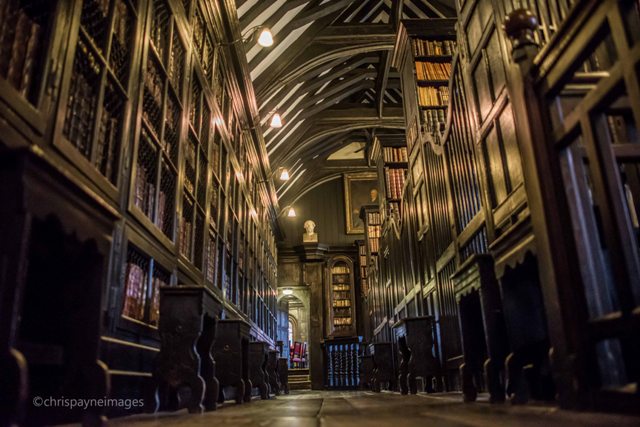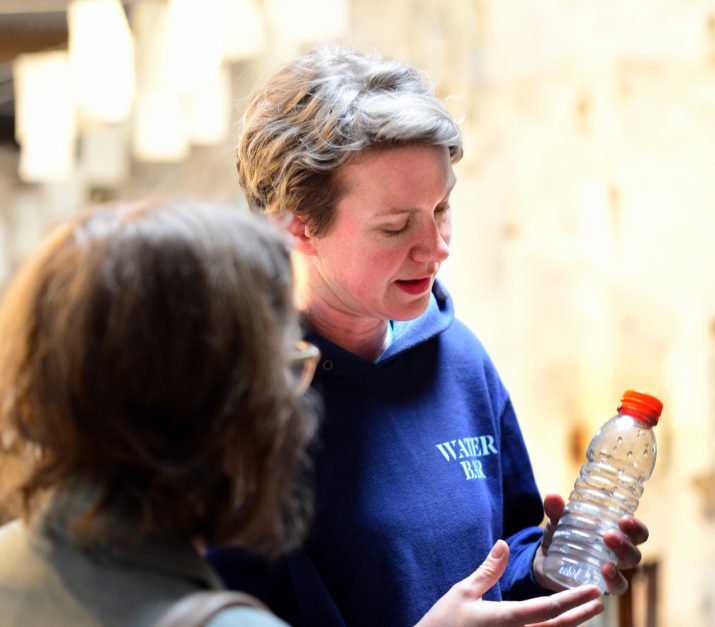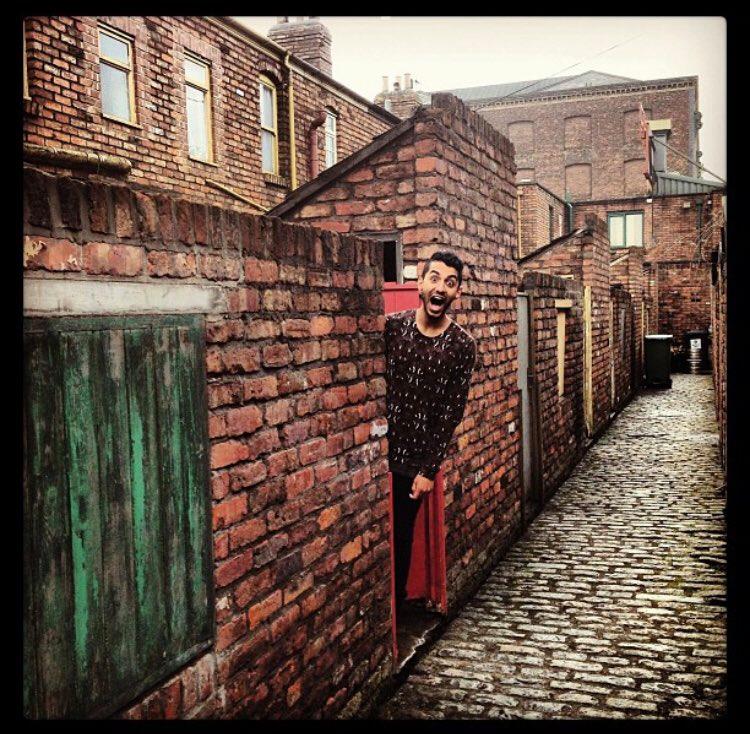Manchester city centre evolves at such a rate of knots these days, it’s entirely possible to feel disorientated if you’ve been away for a fortnight. So there’s something rather reassuring about the knowledge that parts of it haven’t changed for a long time. In fact, certain corners of it are medieval.
Chetham’s is tucked away between Victoria Station, Manchester Cathedral and the National Football Museum. It consists of two elements: a music school which has been in-situ since 1969, and also the library, which is much, much older. They’re pretty much distinct entities, and increasingly so. Thousands of people probably pass by every day, entirely unaware that the library is open to the public, and for free. And it’s a sight well worth seeing.
Northern Soul is lucky enough to be shown round by someone who knows the place better than most: Chetham’s librarian, Dr Michael Powell. A Boltonian by birth, Michael has been at Chetham’s for more than 20 years. It’s an astonishing place, absolutely steeped in history, but Powell is keen that it should remain, first and foremost, a working, growing library. “It really mustn’t become a museum and we’re really conscious of the fact,” he says. “ Museum’s not a bad word, but it’s not to become fossilised. We still buy, we still acquire stuff, we still get stuff often by gift.”
 As a publicly-accessible collection of books, it’s impossible to remain unimpressed. They’re housed in towering wooden shelves and gated sections, along two stretches, and to this day are known by names which hark back to their origins in the early 15th Century. “The building’s coming up to its 600th anniversary in 2021,” Powell says. “It first goes up in the 1420s and originally it’s the accommodation for the clergy of what’s now Manchester Cathedral. We still call one wing the Priest’s Wing, because it was then a dormitory, divided up, and the other one we call the Mary Chapel Wing.”
As a publicly-accessible collection of books, it’s impossible to remain unimpressed. They’re housed in towering wooden shelves and gated sections, along two stretches, and to this day are known by names which hark back to their origins in the early 15th Century. “The building’s coming up to its 600th anniversary in 2021,” Powell says. “It first goes up in the 1420s and originally it’s the accommodation for the clergy of what’s now Manchester Cathedral. We still call one wing the Priest’s Wing, because it was then a dormitory, divided up, and the other one we call the Mary Chapel Wing.”
These prior inhabitants were, to give them their proper titles, the Warden and Fellows of the College of the Blessed Virgin of Manchester. The post of Warden was held, at one point, by the now-legendary John Dee – an advisor to Mary Tudor and Elizabeth I, deeply interested in science and the occult, and, yes, inspiration to Damon Albarn’s recent musical. Signs of Dee’s time at Chetham’s keep cropping up throughout our visit, but actually he’s just one of many figures to have passed through the building over the centuries.
The eponymous Chetham – and in case you’ve always wondered, it’s pronounced ‘Cheetham’, as in ‘Hill’ – was one Humphrey Chetham, a fabulously successful fabric merchant from Crumpsall. On his death in 1653, he left money to fund a school for the poor and a free public library, whereupon the college building was purchased and transformed. “The building is sort of run down and a bit decrepit by the middle of the 17th Century,” Powell says. “Then the public library’s opened in the 1650s, and it’s that ever since. It’s not changed much; I think they put the gates up in the 1750s, and they messed about with the height of the bookcases. Then they stopped at the end of the 18th Century, and that’s it.”
Chetham’s now has the honour of being the oldest free public reference library in the country. Powell pulls down one of a three-volume set of Plato. It’s marked as having been bought for three pounds ten shillings in 1655, making it one of the very first books that the library acquired. Then, inside the cover, an inscription reads, ‘I belong to Ben Jonson’. Which is to say, it’s second hand, and its previous owner was the 17th Century playwright who gave Shakespeare a run for his money. It’s all pretty awe-inspiring.
Unlocking another gated section, Powell opens a private scrapbook of Manchester posters relating to visiting circus acts, dating back to around the 1780s. We marvel at then-upcoming attractions such as General Jack, a performing monkey who could walk a tightrope while simultaneously smoking and carrying a candelabra; and also The Learned Pig. Powell reveals exactly how a pig could appear learned on-stage, but we won’t spoiler you here, just in case you happen to find yourself looking for a good night out in the 18th Century any time soon. 
In particular, Chetham’s houses invaluable material on Manchester’s history, such as an extensive archive around Belle Vue, the zoo which became the city’s premier tourist attraction, taking in circus shows and fairground rides (the archive has recently been digitized and will soon be available to explore online). And then there’s the Leech Collection, consisting of about 200 diaries written by a single family of local mill owners over almost two centuries. Powell himself got to know two of the Leech sisters in their later years.
“When I came back to Manchester 20-odd years ago, I used to run into these two little old ladies called Leech. They lived in this big old house in Victoria Park, and one of them had been a librarian here at Chetham’s after the war, but I didn’t really know that much about them.” Through the Chetham’s connection, the family diary archive was acquired. “Then, eight years ago, we started to get these family diaries, and it turned out that, of these two little old ladies, the one who was a librarian had been a codebreaker in Bletchley Park in World War Two. Her sister, from the age of about 14, was best friends with the novelist Iris Murdoch and had all these letters to and from her.”
In passing, Powell indicates a number of boxes which contain more than two hundred Hogarth engravings. “We didn’t even know we had them until about ten years ago.” An eagle-eyed student noticed that they’d been bound incorrectly, long, long ago, and alerted the library to his discovery.
 Even the reading room here is extraordinary. In fact, for many it’s the highlight of their visit. There’s a main table surrounded by ornate chairs. “These chairs are all 17th Century, and the table is too.” Off to one side there’s a carved bookshelf. “That’s a bit earlier: that’s 1510, something like that. And that was originally a bed, and was turned into a sideboard. I think it’d be fun to turn it back into a bed because when it was a bed – a four poster – Bonnie Prince Charlie slept in it. And you think, that’d be fantastic. Although it probably wouldn’t look very good, having a bed in here.”
Even the reading room here is extraordinary. In fact, for many it’s the highlight of their visit. There’s a main table surrounded by ornate chairs. “These chairs are all 17th Century, and the table is too.” Off to one side there’s a carved bookshelf. “That’s a bit earlier: that’s 1510, something like that. And that was originally a bed, and was turned into a sideboard. I think it’d be fun to turn it back into a bed because when it was a bed – a four poster – Bonnie Prince Charlie slept in it. And you think, that’d be fantastic. Although it probably wouldn’t look very good, having a bed in here.”
There’s a portrait of Humphrey Chetham himself looming above the fireplace, and a collection of chained books is nearby, too, as funded by the man himself. One of these books is Edward Reynolds’ Treatise of the Passions and Faculties of the Soul of Man, in its time a ground-breaking work about the causes of mental and physical illness. Maybe it provided light bedtime reading for John Dee, who used to sleep in this room at one time. Mind you, the brevity of the chain probably precluded reading in bed. Books were luxury item in those days. As Powell explains: “Buying a book’s like buying an Apple laptop in the 1640s – that sort of investment – so that’s why they were chained.”
In an alcove over by the window is a smaller table: this, for some visitors, is the library’s main attraction. “One of the main reasons people come here is this desk, because this is where Karl Marx wrote. We know that [Daniel] Defoe came here, we know that Dickens was here, we know Benjamin Franklin was here – but we don’t know where they sat. But [Friedrich] Engels wrote a letter to Marx, many years later after they’d worked together, and said, ‘I’ve been back and I’ve sat at the four-sided desk in the alcove where we used to work’.” That’s to say, Chetham’s was Marx and Engels’ Manchester meeting place, and work on The Communist Manifesto began right at this very desk, and today most visitors make a bee-line straight for it. “They usually want to sit here and take a selfie,” Powell smiles.
It’s an embarrassment of riches. Down from the library itself, there’s a beautiful stone cloistered courtyard (complete with a 15th Century cat-flap), a timbered Baronial Hall used for performances, and the historic Audit Room, at one time the former Warden’s living quarters. Famously, the large oak table here bears a strange mark in one corner, thought by some to be a burn mark from one of the Devil’s hooves when he was summoned by Dr Dee. Though, to be fair, Powell seems to favour the less fanciful theory that it might have been caused by an unsightly accident with candle-wax.
Chetham’s is currently at something of a crossroads. They may sit side by side, but, as Powell says, “the library and the school are completely separate”. Increasingly, the music school is contained within the site’s newer buildings (it’s been making headlines for all the wrong reasons recently, too, but that’s another matter). Potential visitors might not be aware of exactly what the library consists of, whether they’re free to visit it. But they are, and they should. Plans are in place to open it up yet further: to pull down a now disused building which used to be the dormitory for the music school, and, hopefully, to construct an entirely separate visitor’s entrance for the historic library side, to make it more obviously accessible. Powell looks particularly wistful at the thought of reinstating an alligator which used to hang from the ceiling back in the day, as noted in a ballad about visiting the library during the 1830s. The funding for such developments is, all being well, nearly in place. True to Humphrey Chetham’s original intentions, visiting the library remains completely free of change, though a small donation would be welcome.
Aside from being a fascinating public resource, Chetham’s is a real architectural gem, a little corner of history slap-bang in the middle of Manchester. It’s striking and hugely evocative – not for nothing did it appear on-screen last Christmas as the location for Mark Gatiss’s BBC adaptation of MR James’s eerie tale The Tractate Middoth. 
Indeed, the most obvious responses from visitors must surely be ‘Wow!’, followed closely by ‘It looks like Hogwarts!’. And yet, Powell reckons that the school groups who visit Chetham’s today are a generation along from the Harry Potter crowd. “In many ways that’s gone. It’s surprising, but when kids have come in now and we’ve said, ‘It looks like Hogwarts’, they’ve often looked completely baffled, because it’s gone already. It’s moved on.”
If you need an object lesson in the passage of time, there it is. Fleetingly fashionable boy wizards may come and go – but Chetham’s is still standing strong.
Images by Chris Payne
 For more information on Chetham’s Library, including details on how to arrange a visit, see their official website: www.chethams.org.uk
For more information on Chetham’s Library, including details on how to arrange a visit, see their official website: www.chethams.org.uk
With sincere thanks to Dr Michael Powell











